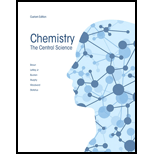
Concept explainers
Carbon monoxide, CO, is isoelectronic to N2.
a. Draw a Lewis structure for CO that satisfies the octet rule.
b. Assume that the diagram in Figure 9.46 Q can be used to describe the MOs Of CO. What is
the predicted bond order for CO? Is this answer in accord with the Lewis structure you drew in
part (a)?
c. Experimentally, it is found that the highest energy electrons in CO reside in a MO Is
that observation consistent With Figure 9.46 Q? If not, What modification needs to be made to
the diagram? How does this modification relate to Figure 9.43Q?
d. Would you expect the MOs of CO to have equal atomic orbital contributions from the C
and O atoms? If not, which atom would have the greater contribution?
Want to see the full answer?
Check out a sample textbook solution
Chapter 18 Solutions
CHEMISTRY:CENTRAL SCI.-W/ACCESS>CUSTOM<
- As the bead engineer of your starship in charge of the warp drive, you notice that the supply of dilithium is critically low. While searching for a replacement fuel, you discover some diboron, B2. a. What is the bond order in Li2 and B2? b. How many electrons must be removed from B2 to make it isoelectronic with Li2 so that it might be used in the warp drive? c. The reaction to make B2 isoelectroruc with Li2 is generalized (where n = number of electrons determined in part b) as follows: B2B2n++neE=6455kJ/mol How much energy is needed to ionize 1.5 kg B2 to lhe desired isoelectroruc species?arrow_forwardUse the MO model to explain the bonding in BeH2. When constructing the MO energy-level diagram, assume that the Bes 1s electrons are not involved in bond formation.arrow_forwardUse the MO model to determine which of the following has the smallest ionization energy: N2, O2, N22, N2,O2+. Explain your answer.arrow_forward
- For each of the following molecules, write the Lewis structure(s), predict the molecular structure (including bond angles), give the expected hybrid orbitals of the central atom, and predict the overall polarity. a. CF4 b. NF3 c. OF2 d. BF3 e. BeH2 f. TeF4 g. AsF5 h. KrF2 i. KrF4 j. SeF6 k. IF5 l. IF3arrow_forwardValues of measured bond energies may vary greatly depending on the molecule studied. Consider the following reactions: NCl3(g)NCl2(g)+Cl(g)E=375kJ/molONCl(g)NO(g)+Cl(g)E=158kJ/mol Rationalize the difference in the values of E for these reactions, even though each reaction appears to involve only the breaking of one NCl bond. (Hint: Consider the bond order of the NO bond in ONCl and in NO.)arrow_forwardReport all your results by using significant figures and use dimensional analysis. a) Write the Molecular Orbital diagrams for F2(2+) and F2(2-). b) Calculate their bond orders. State if the molecule is stable or not. c) State whether the molecules are paramagnetic or diamagnetic.arrow_forward
- Consider these following ions: O2-, N22-, Li2+ and O22- a. Based on molecular orbital theory (MOT), which of the ion(s) exhibit(s) paramagnetism? b. For those ions that are paramagnetic, determine the number of unpaired electrons. Support your answers with draw appropriate molecular orbital energy diagram.arrow_forwardConsider the reaction BF3 + NH3 -> F3B-NH3 (a) Describe the changes in hybridization of the B and N atoms as a result of this reaction. (b) Describe the shapes of all the reactant molecules with their bond angles. (c) Draw the overall shape of the product molecule and identify the bond angles around B and N atoms. (d) What is the name of the bond between B and N. (e)Describe the bonding orbitals that make the B and F, B and N & N and H bonds in the product molecule.arrow_forwardNitrogen trifluoride (NF3) is used in the electronics industry to clean surfaces. NF3 is also a potent greenhouse gas. (A) Draw the Lewis structure of NF3 and determine its molecular geometry. (B) BF3 and NF3 both have three covalently bonded fluorine atoms around a central atom. Do they have the same dipole moment? (C) Could BF3 also behave as a greenhouse gas? Explain why or why not.arrow_forward

 Chemistry: An Atoms First ApproachChemistryISBN:9781305079243Author:Steven S. Zumdahl, Susan A. ZumdahlPublisher:Cengage Learning
Chemistry: An Atoms First ApproachChemistryISBN:9781305079243Author:Steven S. Zumdahl, Susan A. ZumdahlPublisher:Cengage Learning ChemistryChemistryISBN:9781305957404Author:Steven S. Zumdahl, Susan A. Zumdahl, Donald J. DeCostePublisher:Cengage Learning
ChemistryChemistryISBN:9781305957404Author:Steven S. Zumdahl, Susan A. Zumdahl, Donald J. DeCostePublisher:Cengage Learning


